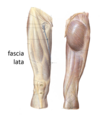Anatomy - Leg circulation Flashcards
What are the two different types of fascia ?
Superficial and deep

What is fascia lata ?
Deep fascia of the thigh

What does deep fascia form ?
Forms compartments separated by intermuscular speta which is deep fascia that separates two muscles

Describe the main overview of the arterial blood supply of the upper limb down to the anastomoses in the hand
Subclavian ===> Axillary ====> Brachial ===> Branches into radial (more lateral one) and ulner (more medial one) ===> deep and superficial plamar arches

What artery predominatley forms the superficial palmar arch and what artery also contributes ?
Predominatley formed by the ulner artery with a contribution from the superficial palmar branch of the radial artery.

What arteries is the deep palmar arch formed by?
Formed mainly from the terminal part of the radial artery, with the ulnar artery contributing via its deep palmar branch, by an anastomosis.

Describe the vneous draing of the upper limb
Cephalic (more lateral) and basilic (more medial) veins drain to ====> axillary vein ====>
R subclavian vein

What is the vein which runs horizontal between the cephalic and basilic veins ?
The median cubital vein

Describe the arterial supply of the lower limb
Femoral (which has a deep branch off it called the profunda femoris) =====> popliteal ====> Branches into the posterior and anterior tibial arteries
Anterior tibial ===> dorsalis pedis ===> arcuate artery (dorsum of foot)
Posterior tibial artery (has a branch come off it called the fibular artery) ===> Branches into the medial and lateral plantar arteries
Lateral plantar artery ===> plantar arch (sole of foot)

At what anatomical location does the femoral artery pass through and then become the popliteal artery ?
The adductor hiatus

Describe the venous drainage of the lower limb
Small saphenous ====> Popliteal vein ====> femoral vein
Great saphenous vein ===> femoral vein

Roughly in what region does the great saphenous vein join onto the femoral vein ?
The inguinal region
Roughly where does the popliteal vein become the femoral vein ?
As it passes through the adductor hiatus
Describe the route of the small saphenous vein
Arises from the dorsal venous arch ===> goes behind the lateral malleolus and then runs up the back of the calf drainging into the popliteal vein (posterior to the knee)

Describe the route of the great saphenous vein
Arsies from the dorsal venous arch ===> runs in front of the medal malleolus and then rises up the mdial side of the upper leg to join with femoral vein roughly at the inguinal region (around the femoral triangle)








